The MG 34 is a German recoil-operated air-cooled general-purpose machine gun, first tested in 1929, introduced in 1934, and issued to units in 1936. It introduced an entirely new concept in automatic firepower – the Einheitsmaschinengewehr – and is generally considered the world's first general-purpose machine gun (GPMG). Both the MG 34 and MG 42 were erroneously nicknamed "Spandau" by Allied troops, a carryover from the World War I nickname for the MG 08, which was produced at the Spandau Arsenal.
The MG 42 is a German recoil-operated air-cooled general-purpose machine gun used extensively by the Wehrmacht and the Waffen-SS during the second half of World War II. Entering production in 1942, it was intended to supplement and replace the earlier MG 34, which was more expensive and took much longer to produce, but both weapons were produced until the end of World War II.
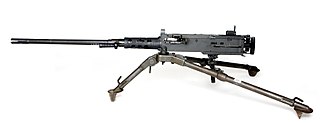
The M2 machine gun or Browning .50 caliber machine gun is a heavy machine gun that was designed near the end of World War I by John Browning. While similar to Browning's earlier M1919 Browning machine gun, which was chambered for the .30-06 cartridge, the M2 uses Browning's larger and more powerful .50 BMG cartridge. The design has had many designations; the official U.S. military designation for the current infantry type is Browning Machine Gun, Cal. .50, M2, HB, Flexible. It is effective against infantry, unarmored or lightly armored vehicles and boats, light fortifications, and low-flying aircraft.

The FG 42 is a selective-fire 7.92×57mm Mauser automatic rifle produced in Nazi Germany during World War II. The weapon was developed specifically for the use of the Fallschirmjäger airborne infantry in 1942 and was used in very limited numbers until the end of the war.
The MG 17 was a 7.92 mm machine gun produced by Rheinmetall-Borsig for use at fixed mountings in many World War II Luftwaffe aircraft, typically as forward-firing offensive armament. The MG 17 was based on the older MG 30 light machine gun, as was its defensive flexible-mount counterpart, the MG 15 machine gun.
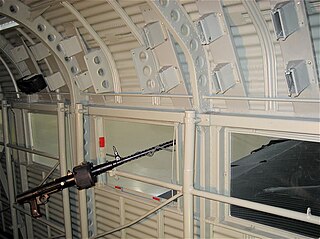
The MG 15 was a German 7.92 mm machine gun designed specifically as a hand-manipulated defensive gun for combat aircraft during the early 1930s. By 1941 it was replaced by other types and found new uses with ground troops.
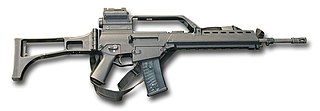
A semi or full-automatic firearm which is said to fire from a closed bolt is one where, when ready to fire, a round is in the chamber and the bolt and working parts are forward. When the trigger is pulled, the firing pin or striker fires the round; the action is cycled by the energy of the shot, sending the bolt to the rear, which extracts and ejects the empty cartridge case; and the bolt goes forward, feeding a fresh round from the magazine into the chamber, ready for the next shot.

The PK, is a belt-fed general-purpose machine gun, chambered for the 7.62×54mmR rimmed cartridge.
Blowback is a system of operation for self-loading firearms that obtains energy from the motion of the cartridge case as it is pushed to the rear by expanding gas created by the ignition of the propellant charge.

The MP 18, manufactured by Theodor Bergmann Abteilung Waffenbau, was arguably the first submachine gun used in combat. It was introduced into service in 1918 by the German Army during World War I as the primary weapon of the Sturmtruppen, assault groups specialized in trench combat. Although MP 18 production ended in the 1920s, its design formed the basis of most submachine guns manufactured between 1920 and 1960.

The MG 3 is a German general-purpose machine gun chambered for the 7.62×51mm NATO cartridge. The weapon's design is derived from the World War II era MG 42 that fired the 7.92×57mm Mauser round.
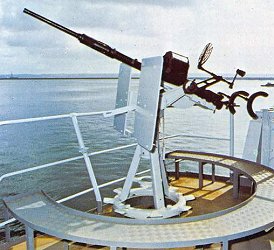
The Oerlikon 20 mm cannon is a series of autocannons, based on an original German Becker Type M2 20 mm cannon design that appeared very early in World War I. It was widely produced by Oerlikon Contraves and others, with various models employed by both Allied and Axis forces during World War II. Many versions of the cannon are still used today.
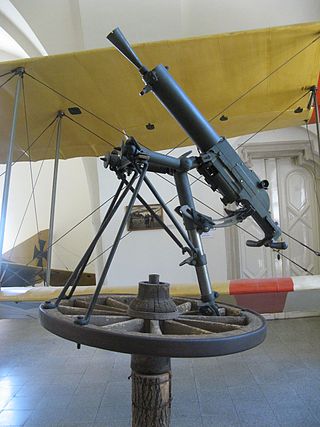
The Maschinengewehr (Schwarzlose) M. 7, also known as the Schwarzlose MG, is a medium machine-gun, used as a standard issue firearm in the Austro-Hungarian Army throughout World War I. It was utilized by the Dutch, Greek and Hungarian armies during World War II. It was routinely issued to Italian colonial troops, alongside the Mannlicher M1895 rifle.

The MG 13 is a German light machine gun developed by converting the Dreyse Model 1918 heavy water-cooled machine gun into an air-cooled version.

The SIG MG 710-3 is a Swiss 7.62 mm general-purpose machine gun (GPMG) designed and manufactured by SIG - Schweizerische Industrie Gesellschaft. The weapon was developed as a commercial venture primarily for export, since the Swiss Army had already adopted the 7.5 mm MG 51 GPMG, produced by the federal arms factory W+F.
The Ameli is a 5.56mm light machine gun designed for the Spanish Army by the nationally owned and operated Centro de Estudios Técnicos de Materiales Especiales (CETME) small arms research institute.

The MG 45 was a machine gun based on the MG 42, which was developed but not fielded in significant numbers by the German Army in World War II.

The T24 machine gun was a prototype reverse engineered copy of the German MG 42 general-purpose machine gun developed during World War II as a possible replacement for the Browning Automatic Rifle and M1919A4 for infantry squads. The T24 was chambered for the .30-06 Springfield cartridge.
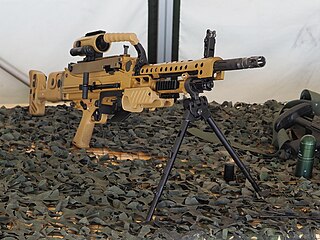
The Heckler & Koch MG5 is a belt-fed 7.62×51mm NATO general-purpose machine gun manufactured by German firearm manufacturer Heckler & Koch. The MG5 resembles the 5.56×45mm NATO Heckler & Koch MG4 light machine gun, which was adopted into German military service in 2005.

The M1919 Browning is a .30 caliber medium machine gun that was widely used during the 20th century, especially during World War II, the Korean War, and the Vietnam War. The M1919 saw service as a light infantry, coaxial, mounted, aircraft, and anti-aircraft machine gun by the U.S. and many other countries.














